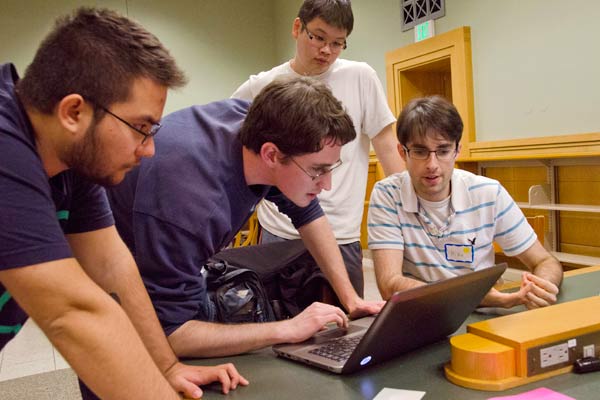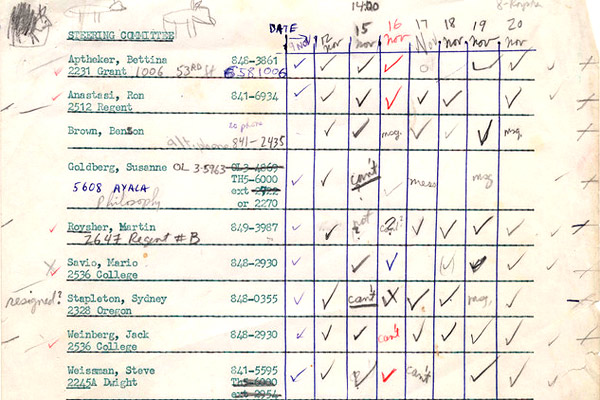Student ‘hackers’ design new ways to research the Free Speech Movement

In the half-century since Berkeley’s Free Speech Movement, the rousing oratory of Mario Savio and iconic images of mass demonstrations have come to stand in for the 1964 movement and its legacy. But all that makes for “a very blurry snapshot,” historian Felicia Viator, a Cal grad and visiting lecturer, told a gathering of students in Doe Library recently.
To really understand the FSM and the whole period one has to go deeper, she suggested. “Broad brush strokes are not enough.”
Her remarks were intended as words of inspiration to kick off HackFSM, a 12-day “hackathon” that, she said, shared the FSM’s aim “to create a free marketplace of ideas.”

For HackFSM, organized by the Bancroft Library and Digital Humanities @ Berkeley, students were invited to develop a compelling user interface to the Bancroft’s Free Speech Movement Digital Archive, a large trove of texts, images and audio recordings that the Bancroft digitized and published to the Web in the mid-1990s. The original online collection was one of the Bancroft’s first forays into digital archiving, and a big step toward making primary-source FSM materials accessible to students and the public, notes Mary Elings, head of digital collections at the Bancroft.
By today’s standards, though, the FSM Digital Archive is static and not very engaging. Researchers can download and read files one at a time, but there’s no way to access the archive as a single data set as scholars in the “digital humanities” and “digital social sciences” are now doing — harnessing computer power to look for patterns across bodies of text, carry out computational analysis or visualize information in new and compelling ways.
Throwing out a challenge
Students were tasked with developing features that would be “helpful to a researcher who’s just exploring the FSM; those might include topic modeling, visualizations, mapping or timelines,” Elings said. “Think of different ways you might want to come into the data if you were a humanist doing a paper.”
"As a human being I can look in an archive through a small amount of newspaper pages per day," said Andrea Horbinski, a grad-student "digital humanist" who helped organize HackFSM. "But if digitized with the right program, I
can analyze a newspaper’s entire publishing history in a few hours.
“Digital humanities is not a way to replace scholars; the data doesn’t speak for itself,” she added. “Scholars must still do the thinking about what it all means.”
Second-year computer-science major Kevin Casey, in the audience, said he’d decided to take up the Bancroft’s challenge because “it seems like a good cause, to help out and make the archive usable.”
His team, and nine others, received a “key” to the data, drew on the combined skills of their techies and humanists (each group was required to include at least one of each), and spent long hours deep in code and FSM documents — right up until Cal Day last weekend, when they presented their designs before a three-judge panel.
Winning design
Four undergrads – Casey and fellow coders Craig Hiller and Alice Liu, along with interdisciplinary-studies major Cassie Xiong – took first prize, which meant a MacBook Air for each.

Berkeley alum Gar Smith was on hand to congratulate the winners. As a student activist in the Free Speech Movement, “my greatest communication tool was a mimeograph machine,” he said as he bestowed the winners with FSM buttons. (Mimeographed FSM flyers can be found in the digital collection.)
The winning interface allows users to search for text, images or audio. It includes a photo-illustrated timeline of FSM highlights and automatically generates bibliographic citations. Audio clips are paired with time-stamped transcripts. The students have made the website available online.
Elings hopes the HackFSM will be followed by similar hackathons, and serve to encourage library efforts to make archival collections even more accessible to researchers and the public. “There’s so much digital content out there that’s not being used as much as it could be,” she says. “It’s there, and we’re building it all the time.”
